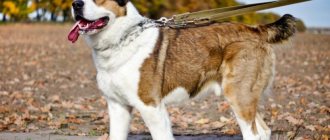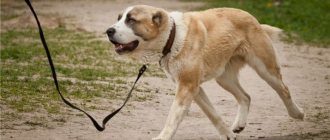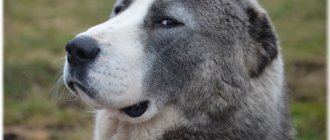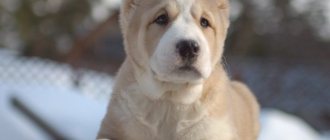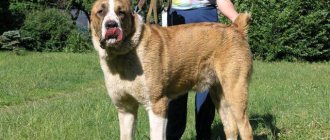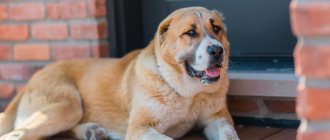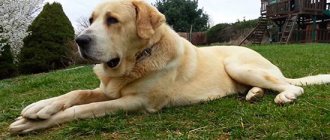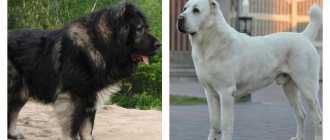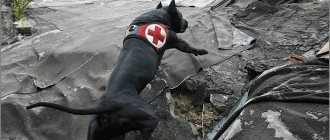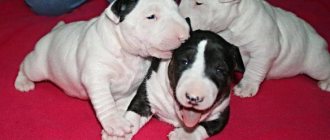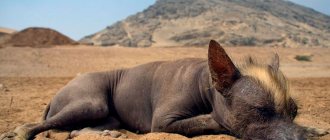The Central Asian Shepherd Dog (CAO) is an ancient and large breed of Asian origin. In its homeland it is also known as the Turkmen alabai or wolfhound. Therefore, the Central Asian Shepherd Dog and Alabai are the names of the same animal.
The Alabai breed is one of the largest breeds in the world. These are strong, brave and noble dogs with pronounced guard instincts. They are capable of frightening the enemy with just their appearance. But the first impression is quite deceptive. With proper upbringing, the Alabai breed shows the best qualities - boundless devotion, good nature and balance.
Standards and appearance
Alabai is a large, harmoniously built and balanced breed of dog. There are no unambiguous indicators of the size of the Central Asian Shepherd. The standard specifies only permissible minimums:
- the weight of an adult Alabai dog is from 50 kg for “boys”, and from 40 kg for “girls”;
- Alabai height is from 70 cm in males and from 65 cm in females.
On a note. The breed has pronounced sexual dimorphism. The Alabai male is much more massive and larger than the female.
According to reviews from owners, the weight of an adult Alabai can reach up to 80 kg with a height of 80 cm. But the larger the dog, the higher the likelihood of joint problems. If an alabai weighs more than 80 kg, you should review your diet and increase physical activity.
The largest Alabai in the world, nicknamed Bulldozer, weighs about 120 kg, but his height is appropriate. On its hind legs, the height of the animal is almost 2 m. Its appearance at dog fights has always created a sensation. Now the largest Alabai is on a well-deserved rest.
Official description of the breed (FCI standard No. 335):
BecomeCharacteristic
| Head | Large, proportional to the body. The shape resembles a square. |
| Muzzle | Quite short, blunt, close to a rectangle. |
| Nose | Large, painted black. In white or fawn colored dogs, lightening of the lobe is acceptable. |
| Jaws | Massive and wide. The teeth are hidden behind dense, well-pigmented lips. A straight or scissor bite is allowed, as well as a bite without waste. |
| Eyes | Medium size, almond-shaped, set wide and straight. The pigmentation of the iris can be any shade: from dark brown to light brown. |
| Ears | Hanging, triangular in shape, set low. In some countries they are subject to docking. |
| Neck | Massive, muscular, cylindrical in shape. |
| Body | Slightly stretched. The withers are especially prominent in boys. Both sexes have a wide back, short loin and deep chest. The belly is slightly tucked. |
| Tail | Expands as it approaches the base. It is shaped like a sickle or twisted into a ring closer to the tip. In some countries it is subject to docking. |
| Limbs | Straight and parallel, set quite wide. |
Important. An Alabai dog with obvious physical or behavioral abnormalities will be disqualified.
According to the observations of dog handlers, the size of an adult Alabai fluctuates within a fairly wide range, so it is almost impossible to name any specific parameters. However, it is permissible to highlight the average weight and height of an Alabai based on measurements of puppies from various litters.
But one should not be surprised if the little Alabai first lagged behind its relatives, and then sharply overtook its fellows. With the Central Asian Shepherd, such surprises occur quite often.
The following is a table of Alabai’s body weight by month, which can be used to track weight dynamics:
Age (months) Weight and height of Alabai
| Newborn | A small alabai looks like a well-fed barrel with short legs. Its weight ranges from 350 to 550 g. |
| 1 | By this time, the Alabai’s height at the withers reaches 30 cm, weight – 3–5 kg. |
| 2 | At 2 months, the weight of the Alabai reaches 10 kg, but the growth does not increase so rapidly: by about 5 cm. The difference is associated with the active formation of the skeleton. |
| By the way, the largest Alabai Bulldozer by this time weighed 20 kg. | |
| 3 | The weight of Alabai at 3 months is about 20 kg, height is up to 45 cm. |
| 4 | At this age, a period of intensive development begins. At 4 months, the Alabai’s weight reaches 30 kg, height – up to 55 cm. |
| 5 | At 5 months, the Alabai’s height increases by 2–3 cm, and its weight increases by 5–7 kg. |
| 6 | At six months, puppies begin to resemble adult dogs - their bodies become wider and more massive. During this period, Alabai weigh 50 kg, height at the withers reaches 70 cm. |
| 9 | Dogs practically no longer stretch in height, but actively build muscle mass. The growth of Alabai at 9 months remains almost the same - 70–75 cm. Weight is 60–70 kg. |
| 12 | A teenager acquires the build and dimensions of an adult dog. Compared to 9 months, Alabai’s height increases by 3–7 cm, and its weight increases by 5–8 kg. |
The table shows average indicators. The height and weight of Alabai may vary depending on individual characteristics, heredity and conditions of detention.
An adult alabai stops growing by the age of 3. Until this time, the pet can gain several kilograms due to an increase in muscle mass.
Exterior
Alabais have a slightly elongated body , which, at the same time, remains proportional. Despite its massiveness, the dog will never look awkward.
The animal’s muscles are quite dense, voluminous, well developed, but the relief is not very pronounced. In addition, Alabai have natural flexibility.
The Alabai's head always looks symmetrical : a short muzzle, the shape of which is close to rectangular, tapers slightly towards the nose. The transition to the muzzle from the forehead is smooth, weakly expressed. The nose is straight and wide, black in color. With white or fawn coat color, a lightened nose is found. The breed has small, shallow-set, oval-shaped eyes with brown tints.
The dog's lips are powerful and quite thick. The upper one should completely cover the lower jaw. The teeth are adjacent to each other and are white.
There are 42 teeth in the Alabai jaw. But if a dog loses or breaks its incisors, this does not interfere with the correct bite at all , and does not prevent the animal from performing at exhibitions. The fangs of the Alabai are very strong, widely spaced from each other. Scissor bite.
Dimensions
- Height at withers . The breed has no upper height limit. Most often, males reach 90 cm. The lower limit for males is 70 cm, for females - 65 cm.
- How much does it weigh ? Males, with an average size of 65 to 78 cm, weigh about 80 kg. Bitches, with sizes ranging from 60 to 69 cm, can weigh up to 65 kg.
- Color . Various colors are acceptable for the Alabai: black, white, gray, brindle, piebald, fawn, speckled. The only unacceptable colors for this breed are liver and various shades of blue. The reason for this feature is the mixture of Great Dane or German Shepherd. Sometimes the wolf color is brown or zone-red.
- Wool length . The Central Asian Shepherd has two types of hair: short, the length of which does not exceed 3-4 cm, and medium length - about 7-8 cm. The guard hair is quite thick and hard, tightly fitting the body. Alabai has a thick and soft undercoat, thanks to which the animal is protected in such unpleasant weather conditions as wind, severe frost and rain.
Alabaev color
Turkmen Alabais are covered with straight and slightly rough hair with a thick undercoat. The breed standard allows for a wide range of colors:
- White Alabai has a solid, monochromatic color, which is why it resembles a polar bear. Spotted colors are acceptable, when black, red or gray marks are randomly scattered across the body;
- Red dogs' fur can be any shade - from golden to brown. Spots on the chest, belly, muzzle and limbs are not considered a fault;
- black alabai is distinguished by a coal-black color, both uniform and diluted with markings;
- Alabai can be black and white - this is one of the most common colors. There are two options: dark spots are present on a white background or light spots on a dark one;
- The fawn color of the Alabai resembles river sand. On the underside of the body the shade is slightly lighter; there is a dark mask on the muzzle;
- The Central Asian Shepherd Dog of brindle color has thin black stripes scattered over a brown, fawn, yellow or gray background. Sometimes there are so many of them that the animal is mistakenly considered piebald;
- The gray Alabai is covered with hair with a light, pigment-free band, which divides it into several zones. At the base the fur is light, then there are colored areas. The tip can be either light or dark.
The most valuable are black, tiger and white alabai. Genetic brown or blue coloring are disqualifying faults.
Varieties of the Central Asian Shepherd Dog breed
Along with the Caucasian Shepherd, the Alabai is a group of aboriginal dogs that lived over a vast territory. Animals developed in isolation from each other, so they have differences in appearance and temperament. The current standard does not reflect the entire variety of forms of the Central Asian Shepherd Dog.
Depending on the place of residence, the following types of Alabais are distinguished:
- Mountain is a massive long-haired Alabai. A low center of gravity allows him to maintain balance during mountain treks. It is distinguished by its independence, balance, and resistance to severe frosts.
- Steppe animals are light, dry and long-legged. Usually these Alabai are smooth-haired. They are more mobile, energetic and resilient. In some areas they are used as hunting dogs.
- Turkmen Alabai is the original species that laid the foundation for the breed. This is the largest species of all varieties of alabai, a classic representative of the Northern Okrug, which is used for guarding and grazing livestock. In Turkmenistan, alabai are recognized as a national treasure. They are prohibited from being exported from the country;
- Kazakh Alabay (Tobet) is a rather rare variety of Alabay. These animals are a little lighter and more resilient, perfectly adapted to long running. Their guard instinct is slightly less developed than that of the East European Shepherd (Oriental Shepherd);
- Armenian Alabai (Gampr) is a large, efficient dog with powerful jaws originally from the Armenian Highlands. Divided into long-haired and short-haired subtypes;
- Siberian Alabai is a cross between a German Shepherd and a Husky. The Siberian Alabai is distinguished by obedience, affection for people, and high intelligence;
- Tibetan Alabai is the result of crossing with the Tibetan Mastiff. Very rare species;
- Uzbek alabai (buri basar) is not as large as the classic SAO. It has a lighter build, an elongated body and an elongated muzzle.
Important. Curly or excessively long hair is a serious fault, which indicates an admixture of other breeds.
The following varieties of alabai are known:
Recently, a new variety has appeared - the Turkish Alabay, but there is no information about its breeding in Turkey. Therefore, the history of the appearance of these animals remains a mystery even to specialists. The Turkish Alabai still remains in the shadow of more popular guard and herding dogs.
A mini Alabai is considered a deviation from the norm. Most often these are mestizos, similar to the Central Asian Shepherd, but much smaller in size. Professional breeders reject such individuals, but amateurs often keep them as pets.
A wide range of Alabai colors - from white to black - applies to all varieties.
Important! Unscrupulous breeders sometimes sell breeding dogs, passing off puppies as a new variety of Central Asian Shepherd Dog. For example, American Alabay. In fact, such animals do not exist.
Description and breed standard
Representatives of the Alabai breed are large, strong, stately dogs with a harmonious physique and well-developed muscles.
From 1993 to 2010, some changes were made to the breed standard of the Central Asian Alabay Shepherd Dog regarding the requirements for bite and color, as well as minimum height at the withers.
Medium sizes
Currently, the FCI standard No. 335 of October 13, 2010 “Central Asia Shepherd Dog” is in force, which determines what the Central Asian Alabay Shepherd Dog looks like based on the following main characteristics of the breed:
- the minimum height at the withers is 70 cm for a male, 65 cm for a female;
- weight - for males from 50 kg, for females - from 40 kg;
- body length slightly greater than height at withers;
- the head is massive, wide;
- the muzzle is voluminous, rectangular in shape, its length should be in the range of 1/2-1/3 of the length of the head;
- ears are low set, medium in size, triangular in shape, hanging, can be cropped;
- the eyes are medium-sized, round in shape, widely spaced, dark in color, black eyelids;
- the nose is large, dark, but can be lightened with a fawn or white color;
- lips are thick; when closed, the upper lip partially overlaps the lower;
- wide jaws with white strong teeth, scissor bite;
- the neck is muscular, of medium length, with dewlap;
- the chest is wide, elongated;
- the back is straight, strong, muscular;
- limbs are straight, massive oval-shaped paws with claws of any color;
- the tail is set high, thick at the base, and crescent-shaped before docking;
- The coat is thick, straight, hard, with a well-developed undercoat. There are short-haired Alabai with a coat length of 3-5 cm and long-haired ones with a guard hair length of 7 to 10 cm;
- The color can be any, except brown and blue in any combination, as well as saddleback. The most prized animal is the white alabai, which is very similar to a polar bear. A black dog may have small spots of gray, white, brown, or brown;
- movements are balanced and soft.
Compared to a person
Important! Ear and tail docking for Alabais is not a mandatory requirement of the FCI standard.
A dog that has any deviation from the above characteristics (light eyes, high-set ears, thin lips) does not meet the breed standard of the Central Asian Alabai Shepherd Dog.
The result of selection work was the emergence of the following officially recognized varieties of the Central Asian Shepherd Dog: Turkmen Wolfhound (primary species), Caucasian (obtained by crossing with the Caucasian Shepherd Dog), Tibetan (the result of mating with the Tibetan Mastiff) and Turkish Alabay (the youngest population).
Central Asian Shepherd: characteristics of the breed
The character of the Alabai is confident, independent, balanced and proud. Animals are unusually strong, resilient and efficient. The main characteristics of the Alabai breed are courage and absolute fearlessness. Pets selflessly protect their owners from any enemy. But the SAO never attacks without a reason.
The character of the Alabai male and female is very different. “Boys” are slower and calmer, but they start fights more often. It is better not to keep several males in one territory, as conflicts for leadership are inevitable. “Girls” are more active and flexible. They need more attention from their owner.
The negative characteristics of the Alabai breed have taken root among the people. Fans consider dogs to be overly vicious and dangerous. However, CAOs show aggression only in the absence of education and proper socialization. Alabai is more wary than hostile towards strangers.
Important. It is better not for beginners to get an Alabai dog - only a person with a strong character can raise an adequate and manageable pet.
Attitude towards children
With proper upbringing, the Alabai dog treats children calmly if they do not cross the boundaries of what is permitted. To avoid problems, your child should be taught about dog body language and the rules of behavior with an animal.
It is best if the Asian Shepherd and the baby grow up together. Gradually they become fast friends. Good and early socialization guarantees adequate behavior of the pet.
An adult dog needs time to get used to a child. First, you should control the situation - observe the behavior of the animal. Typically, Central Asian Shepherds quickly understand what is required of them and try to keep their distance from the youngest member of the family.
Watchdog and security qualities
The SAO has a well-developed guard instinct. If the owner gets a representative of the Alabai breed to guard a private home, he must raise the dog strictly and train it accordingly. Innate abilities are not enough for a dog to become a reliable protector.
The pet should undergo OKD to develop obedience and learn a basic set of commands. An experienced dog breeder can conduct further training independently. It is better for a beginner to contact a dog trainer or take a ZKS course. Then the dog purchased to guard a private home will cope perfectly with the responsibilities assigned to it.
Care and maintenance
The big alabai is unpretentious in food and care.
Mandatory procedures:
- brushing once a week, and daily during shedding;
- regular eye examination, cleaning if necessary;
- trimming nails if the pet does not grind them down on hard surfaces on its own.
It is enough to bathe the CAO once a year. Like other breeds, these dogs are vaccinated annually and treated for worms and blood-sucking parasites every three months.
Alabais are in heat
Representatives of the breed become mature by two years. The Central Asian Shepherd Dog comes into heat once a year, usually from August to February. The average duration is 21 days. The best time for mating is from the 11th to the 17th day.
Pregnancy
An Alabai dog stays pregnant for 60–65 days. The period may be slightly longer or shorter depending on the size of the litter.
In the first month, the female gains a little weight and shows aggression towards dogs of the same sex. By the end of the third week, clear mucous discharge appears from the loop. By the middle of pregnancy, other signs become visible - the belly grows, the nipples swell. Central Asian Shepherd puppies are usually born without human assistance.
Aviary and booth
It will be cramped for a pet in a small apartment - the Turkmen Alabai has lived free in the steppes for centuries. The ideal option would be a private house with a spacious plot. The large Alabai easily jumps over fences and likes to dig under the ground, so it is better to keep it in an enclosure.
Alabais are dogs that are immune to frost. Therefore, the dog must have a kennel. It must be installed so that the pet can see the entire surrounding area. Otherwise, he will ignore the home, trying to take a more comfortable position.
On a note. CAOs living in the yard also need walks.
Caring for puppies
The Central Asian Shepherd puppy looks like a cute teddy bear. From the first days of arrival in the house, the puppy begins to be raised. The baby is taught to relieve himself on the street, to maintain a regime of activity and rest.
On a note. Purebred Alabai is a rarity. Dogs of Turkmen origin are sold in the Alabai breeding kennel “Turkmen Kala”.
In the warm season, Central Asian Shepherd puppies can immediately move outside. An aviary or a spacious kennel should be installed in the yard. To prevent the Turkmen Alabai from getting bored, they buy him a variety of toys.
Central Asian Shepherd puppies grow quickly. For full development, small Alabais need a balanced diet.
The frequency of feeding depends on age:
- up to 3 months – 5 times a day;
- from 3 to 5 months – 4 times;
- up to 8 months – 3 times.
From 9 months, Central Asian Shepherd puppies eat like adults. If a large alabai lives in an apartment and moves little, one feeding is enough.
Even in childhood, Central Asian Shepherd puppies must get used to hygiene procedures. They are carefully combed and try to trim their claws. If the Alabai puppies tolerate all the procedures, they are generously praised and treated to a treat.
The Big Alabai is a courageous dog with an innate guardian instinct. She will do an excellent job guarding a private home, and with proper upbringing she will become a loyal friend and family member.
Care, maintenance and feeding
It is not recommended to keep Central Asian Shepherds in an apartment, since individuals of this breed are accustomed to the vast expanses of the steppes of Central Asia. It is best to keep them in a private house with an enclosure, a comfortable booth and not on a leash.
Alabais are unpretentious in maintenance. When caring for your pet, the owner must:
- bathe no more than twice a year so that the coat does not lose its natural properties. Normally, the coat should look shiny and dense; if it seems disheveled, then the animal is sick. After walks during periods of dampness and dirt, only the paws should be washed;
- walk with the puppy after he reaches three months of age in a muzzle , choosing deserted places for this. The timed walk must last at least two hours. The dog needs a lot of physical activity, so you should go jogging, overcome ups and downs;
- periodically trim the claws , clean the ears (about once every 2 weeks) and wipe the eyes (if there is accumulated discharge in the corners) with a cotton swab moistened with tea leaves or chamomile infusion;
- During shedding, comb the coat daily, at other times - no more than once a week.
If you want to crop the ears of an Alabai dog, then it is important to know how and when it is optimal to do this so as not to harm the dog. This procedure is recommended for a puppy between 5 and 10 days of age, until the nerve endings in the ears are activated, which eliminates the need for anesthesia. At a later age, general anesthesia is necessary.
Alabais can be fed with natural food or high-quality dry food. In the first option, the basis of nutrition should be meat products (offal, tough beef), so that the individual works with its jaws, and the diet must also contain cereals, vegetables, boiled fish, and cottage cheese.
- I am hungry!..
